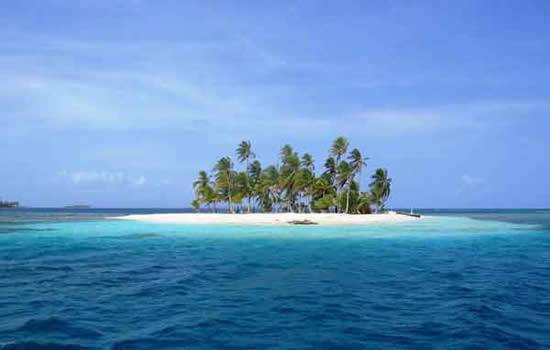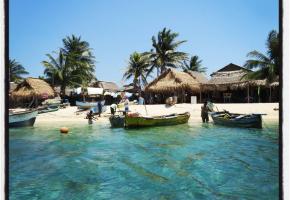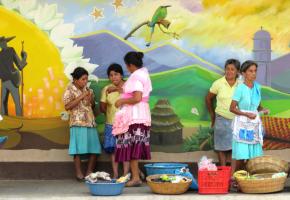Landing in Panama City
From the air, she twists from Costa Rica into a horizontal position like a Freudian patient, her legs falling off the couch into Colombia. On the ground, her warm night envelops me. Loose and confident, lean café con leche skinned boys swagger past, their white welcome teeth gleaming. Their cool slither is not a pretend one, but blessed by an environment that calls for calm. My eyes follow. My muscles relax. And my European city tension dissolves somewhere between the microscopic drops of humidity and the hustle and bustle of laughing taxi men.
Standing on the balcony of the posh Hotel Intercontinental in Punta Paitilla you overlook the pretty colonial buildings of old Panama on the other side of the bay. It’s a taxi drive away along the main road, Avenida Central, cramped with brightly painted buses and honking cars. Traders holler in the city heat, wiping the dirt and stress from their brows, and groups of school girls in clean white shirts and grey skirts skip and tease the ladies in pink hot pants and flip flops who file their nails in doorways, with rollers in their hair.
The neglected buildings-turned-whorehouses of the old centre don’t look as folkloric as they did from my balcony. But there is something special, something Central Havana-ish about Panama’s old city. Original residents wave enthusiastically out of balconies and children play football barefoot in the bays underneath. The fact that renovated government buildings share space with original residents in this not0quite-finished refurbishment of the centre is reassuring. One hopes the tourist job doesn’t get too complete.
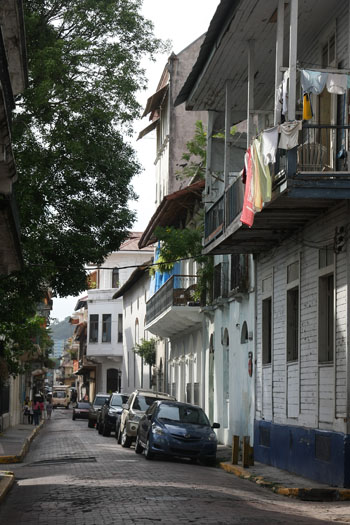
Minutes later, we are a world away from the chaos of the city’s main drag, inside the pristine land of Canal Zone suburbia, where water sprayers are hissing over the lawns of the administrators’ apple pie homes.
Suddenly I’ve been transported to 1950s small town Ohio, with its post office, white spire church and candy store. I imagine crew cut boys in stripy shirts sit on stools sipping sip milkshakes while diplomats and military officials slumping about with the officious glumness of the white man’s burden. But it´s a ghost town and the army barrack buildings nearby are derelict.
Panama was created when it seceded from Colombia in 1903. In one of the most preposterous cons in history, a treaty was signed agreeing that in return for the military support, which would make secession possible, the US would have the rights to build a canal, own it and a vast area around it. The treaty, which was signed on behalf of Panama not by Panamanian but a French engineer, was so unfair that even the US Secretary of State, John Hay, admitted privately to staff that it “was vastly advantageous to the US and, we must confess, not so advantageous to Panama.”
Panama then existed as a virtual client state of the US. But most of the 40,000 Americans who used to live here have already packed up and gone, leaving well-kept lawns on the Pacific horizon and tranquillity that follows the key into the sunset.
The Barrio experience
Instead of going to the famous Panama Canal itself (apparently one of the seven man-made wonders of the world) I decide to head north of the city where migrant squatters have cut back the long grass and banana trees to erect humble wooden shacks. In the last of the orange sunlight children play barefoot in the streets, fat ladies swing in hammocks on verandas and plump couples in flip-flops are pressed together in chubby harmony as they shuffle in rotation to the salsa. I love this feeling of just walking around a neighbourhood. Another’s neighbourhood.
I come across a group of teenagers, still in their school uniforms of short-sleeved cotton white shirt and grey slacks, or skirts for girls. The two mulattos are tall, slim and handsome,and the girl stands chest out and proud. Her Afro is braided and tied with colourful bows and her lilac eye shadow makes her hazel eyes even more striking. Leidy, Rory, and Oosnavi are their names. Oosnavi, that´s a strange name, I say. The boy replies that it is taken from the famous plane that flies daily over their skies.
“Oh!” I laugh. “You mean US Navy!”
“Yeh, that’s it!” he answers, delighted at my recognition. The kids are warm and friendly. They ask me where I am from, and bombard me with questions.
“Someone told me that in England they all eat out of tins because there’s no proper food. That you don’t have fresh fish and vegetables, like we have here. Is that true?” says Oosnavi. “England?” Leidy continues, with a cheeky smile. “Isn’t that the place where people commit suicide because it’s so dark?”
“No, that’s Sweden.” I reply, almost offended. After all, it is the home of the English princess she is named after. She thinks Lady Di is Britney Spears’ mother. I suppose she is perfectly entitled to; why should it be only Brits and Americans who are careless with foreign facts?
Sunday in El Chorrillo with Jeisel
In the mid-afternoon of any given Saturday, El Chorrillo is heaving with parents and children eating the delicious fried fish and plantain from the street stalls and dancing around enormous throbbing speakers blaring reggaetón. Relatives and friends from all over the city embrace like long-lost loved ones, even though it was only the Sunday before that they last met. Dads in freshly ironed shirts are already being chased by mums with baseball bats (who’ve just ironed the shirts), after having made some indecent proposal to a neighbour.
A lashing of energy shoots through me. This is real. This is Panama. Proud. Warm. Honest. The ground below feels dense. My feet sink in, and yet it is a spring-board. Like secrets under the skin vibrating with truth, exciting me with their unknown and calming me with their familiarity.
As night falls, Chorrillo youth emerges fresh from the shower, splashed with cologne, baggy dungarees hanging off their polished and powdered torsos. The girls in mini-dresses move like sphinxes, their black skin glowing against the grim surroundings. “Prrreeeettty,” hiss the boys as they brush past.
Jeisel leads me through the sweaty crowd of boys in string vests grinding their pelvis’s into barely covered booties. He spots his old mates by the stall of Super Q, one of Chorrillo’s two reggaetón stations that come out on Sunday to compete for the Chorrilleño music market.
We walk towards Jeisel's house, down the untarmacked Avenue of the Martyrs, a makeshift memorial to the thousands of Chorrilleños who were injured and killed when they stormed the Canal Zone in 1964. Their relentless protests helped get the Canal back.
From the street we can see Jeisel's mother, a big woman sporting an extravagant gown of scarlet satin with erect fans sown into the shoulders. Leticia greets us with her big smile. She delicately perches her robust curves on the edge of a lived-in armchair, placing her hands on her tightly pressed knees as if to impress upon us her refinement. She excuses herself to take a phone call and suddenly a volcano of emotion erupts from under her princess posture. As her body shakes in excitement and fury, her tongue demolishes the caller on the other end of the line. When she is finished she turns around with an angelic 'not me' smile, perches again and continues to smooth her painted nails over the details of her Sunday frock. I ask Jeisel in a whisper who it is she is angry with, but she hears me. “Oh, some woman my mother gave birth to,” she snaps.
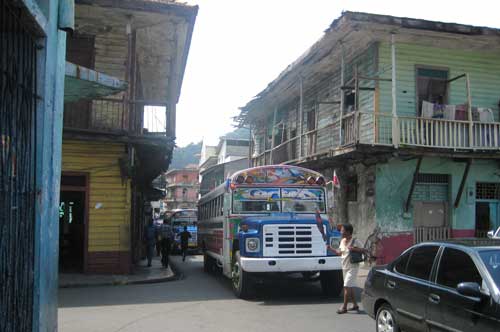
Behind Leticia hangs a poster of the great welterweight champion Roberto “Hands of Stone” Duran. It depicts the famous moment in 1980 when the born and bred Chorrilleñosnatched the WBC crown from Sugar Ray Leonard, dazzling the world with his macho ferociousness and conviction.
The night is young and Leticia is dressed up for dancing. Herpapi arrives in a scarlet suit, white hanky peaking out of left breast pocket, a blood-red banded Panama hat to match and a wide collared red and white striped shirt opened to reveal a thick gold chain. I gaze in awe, that is Style. El Caballero (The Gent) gives Leticia a smacker on the lips before demanding his ‘tiqueta negra’. After swigging his glass of whisky, he rubs his hands together, swings around on his feet and we follow in the trail of his snazzy shuffle down the street. We come to a petrol station where, behind a barbed wire fence, a soft light streams out of the crack of an almost shut garage door.
“El Boyo Florencia”, announces The Gent with a grin. Behind the garage door is a large patio, around which groups sit at floral covered tables and plastic chairs. They watch papis with big wiry Afros cutting the moves in pinstriped bell-bottoms and matching lapels.
A few drinks the better and Leticia is nuzzling up to a smooth operator in a dark velvet brown suit and matching bow tie. El Caballero appears indignantly to defend his territory. She turns to him blushing and reverts to her shy violet pose as she lets herself be led to the floor. Her sexuality is contained in the tight, decorous movements of her large swinging buttocks. This is the generation of pudor: lust is implicit in the quiet pulse of the music.
I am off with some Super Papi in a nylon burgundy suit, dancing to a 1970s Stevie Wonder salsa rendition… “Ooooooh, ooooh,oooooh….parrt tie lohverrr”. With effortless elegance, my partner glides like an ice skater. Not one bead of sweat falls. I drip with perspiration in my skimpy skirt and top.
San Blas archipelago with Rana
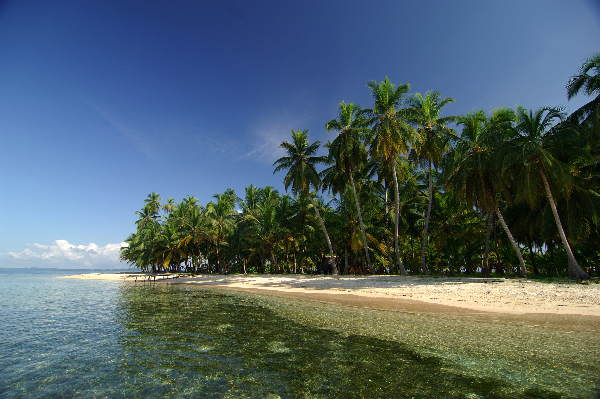
Rana, an indigenous Kuna who lives in the city, invites me to go and visit his family in the archipelago of San Blas. His tribe live on one of the three hundred and sixty five islands off Panama’s Caribbean coast. News has come to him of a cruise ship and he wants to sell his jewellery to the three thousand tourists who will flood out to stare at the mud huts of his old shore.
We fly in our rickety eight-seater over the Darien jungle, which covers Panama south of the Canal all the way to Colombia, towards the Caribbean coast of Panama where Rana’s islands lie. I cannot keep my eyes off this massive green breathing organism below, seeming to expand and retract with all the life it contains. I imagine its panthers, butterflies and alligators, a million medicinal plants and trees, a world so alien to the one I am living inside people’s heads. Down there, the sun, moon, mountains, animals, forest provide all the truth and meaning one needs, not an imaginary one projected on a Coke can or a distorted one on TV. Then we come to the liquid mosaic of fluorescent turquoise and deep blue, speckled with perfect desert islands, the lining of white sand bursting out of the blue like radioactive bacteria. Absolutely stunning.
The plane screeches to a halt just as we are about to fall off the end of an island. The pilot jumps out first, reaching for his fags. I grab some shade in the palm-tree waiting room while Rana negotiates for a boat to take us to his island. As we wait for someone to pick us up, Rana tells me about his culture, how his people live, what they eat, what they wear. The stress he places on my shows he is full of pride. He tells me of life on the water, the fishing tradition. He tells me tales about hunting the seas, battling with sharks and other monsters.
It is late afternoon when a boat comes, a good five hours after our arrival. I had suggested we swim the distance to Rana’s island, which must be only three hundred metres away, but he reacted with intense disapproval as if it were an insult to local custom. Our arrival is met with little more than a few grunts of recognition from Rana’s relatives, not the welcome I’d imagine after a ten-year absence. He tries to shrug the rejection off, but I can see in his subtle flinching, the pain and insecurity it has caused. Rana, like a Seattle teenager in his baggy khaki pants and vest, looks so different from the islanders in their traditional mola garments embroidered with fish and birds. He shows me our hut and I can just about make out the silhouettes of a bed, a sink, and a dish of fried fish in the corner. The sun has gone to bed and there is no electricity to keep us awake.
I am woken up the next day by a laser ray of sun taking my eye out through a gap in the wooden boards. I lie in the hammock on the balcony that hangs over the water’s edge. Rana soon joins me and begins his commentary on the traditional morning activities of his people and his culture.
I convince Rana, despite his reluctance, to take us out on one of the two unused boats in the small harbour. He tugs at the engine so hard it wrenches and wheezes until it gives up. A small group of children are standing on the tiny pier giggling. One of them has called an old man who comes running and shouting in despair. He jumps into the boat and after shaking of the tank, pulls the starter and begins the motor. Slightly embarrassed, Rana wants to speed off as quickly as possible and stalls the engine several times. All that about my culture, city life has obviously made his boating skills rusty!
But I am in paradise, bathing in the crystalline waters, teasing the leering barracudas. I have never seen a Caribbean spot do virgin and unspoilt. No hotels. Bliss. We soon shore up on a white sand bank, the most perfect desert island you’ve ever seen. An old man shuffles through the sand to greet us with his hand out, which is not to be shaken but to collect the dollar fee for stepping on his island. The signpost he stands next to says Dog Island. The man tells us it is named after the creature his grandfather found on it when he first landed there a hundred years ago and, by the way, for another dollar he can offer us a coconut.
Underneath the name of the island are two other words in English: WANT WIFE.
“I will die soon,” the man explains, “and if I do not have children to inherit my island, people will take it back from me.”
He disappears, returning two minutes later with a photocopied sheet listing the qualifications for the position. They include cooking, cleaning, and three hours of love making a day.
“Once she is here she will never be able to leave!” he says, holding his finger in the air triumphantly as if he has just announced a five-year economic plan for the nation.
One American woman, he tells us, professed her love for him but after a month would refuse to make love to him and then left him alone while she visited her family in Virginia.
“What kind of commitment is that?” he asks.


